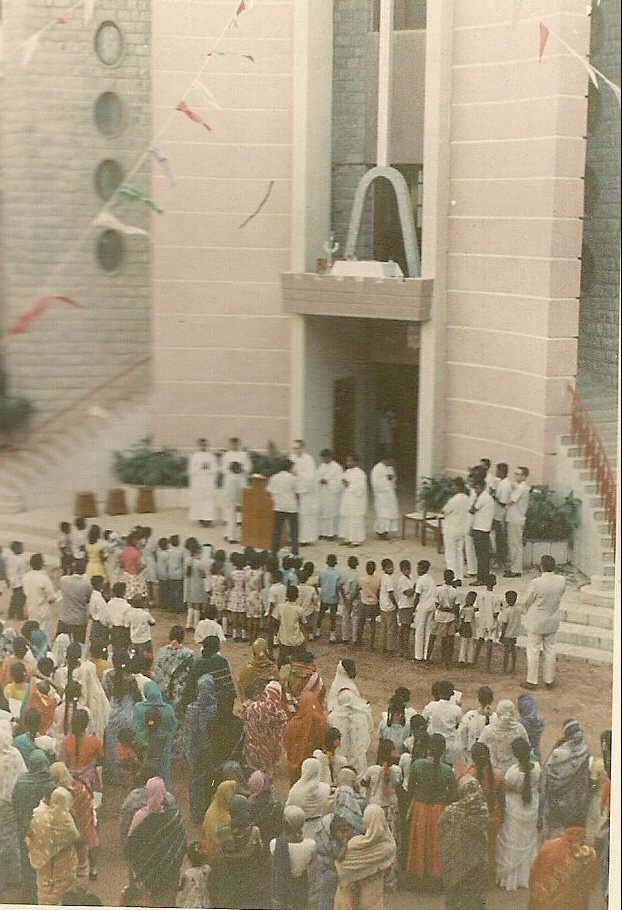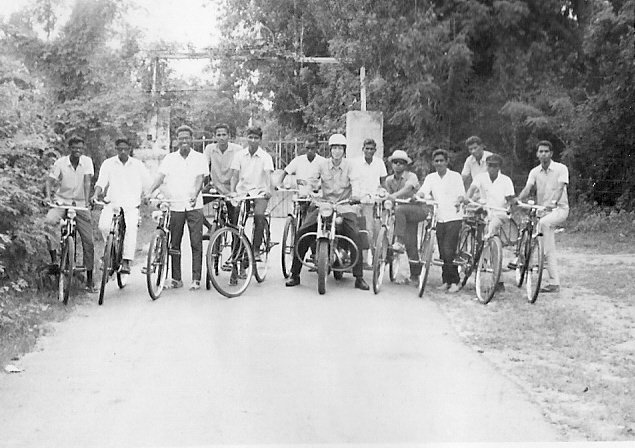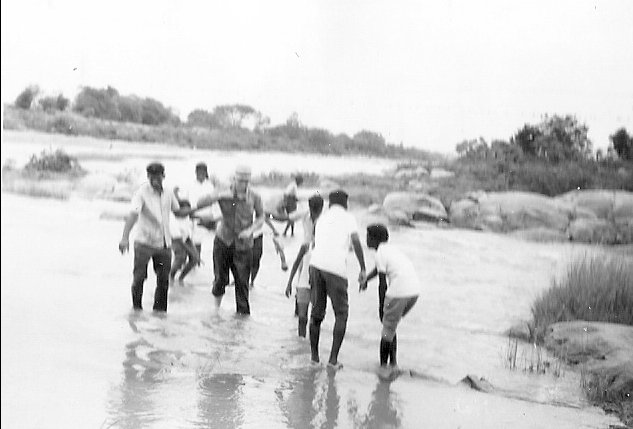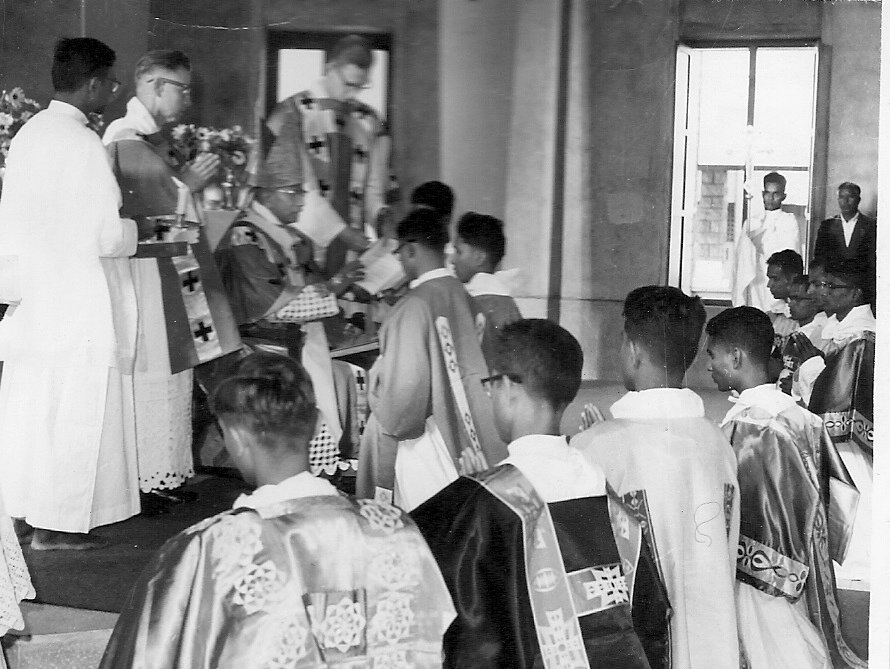I was appointed professor of Sacred Scripture at what was then known as St. John’s Major Seminary in Hyderabad. A major seminary is a college in which future priests, called ‘seminarians’, study philosophy and theology before their ordination. Few people in India understood the term ‘seminary’. We often got letters addressed to St John’s Cementary, St John’s Censustry, or St John’s Cemetery(!). Today the name is often misunderstood internationally, devaluing its professional standard. In this book I will refer to it as St John’s Theological College, or simply St. John’s College. It was run by a fully qualified academic staff.

Me presiding over a function for people from the local parish in front of our college chapel in 1976.
Hyderabad was at the time the capital of Andhra Pradesh, an Indian State that encompassed present-day Andhra Pradesh and Telangana. It was the fifth most populous state in India. The original inhabitants had been Dravidians. In the pre-Christian era, Aryans conquered the country and amalgamated with the population. In 1964 the State counted seven Catholic dioceses with a total of 460,000 baptised members.
Andhra Pradesh was at that time one of the regions of India in which many people felt attracted to Christianity, in marked contrast to the hostility or indifference displayed almost anywhere else. Look at the facts. The Catholic Directory of 1875 registered only 24,173 Catholics in Andhra. By 1964 these had grown out to 500,000! Fr. J.F. McGlinchey who visited Vijayawada in 1922 on behalf of the Propagation of the Faith made this observation:
“The mission of Bezwada [= Vijayawada] is one of the most promising in India. Outside of the city people would stream into the church in large numbers if only more missionaries could be found. Whole villages are ready to undergo instruction and embrace the faith, if the bishop could only supply the necessary personnel to go among them . . . The number of catechumens might easily be ten times larger with more men”.[i]
The need of fostering local vocations and training suitable candidates to become priests was obvious. After some earlier attempts, a major seminary for all of the Telugu speaking area was established in Nellore in 1926 by the Mill Hill Missionaries. This institution was transferred to Hyderabad in 1963/1964, at exactly the time when I arrived in India to take up my teaching post there.[ii]
Staff and student body
At my arrival the academic year was already in full swing. We were ten on the staff, most of them colleagues of mine, Mill Hill missionaries, but we also had the first Indian professors. The students, in a two-year philosophy and four-year theology programme, soon numbered 180.
My principal task was to teach sacred scripture. As Dr Gali Bali and I were the only scripture professors it proved a real challenge. The college library collection was very small – more about that later – and preparing lecture material on topics ranging from the old testament prophets to the Johannine letters taxed a lot of my energy. Moreover, we were short of good handbooks and effective teaching requires more than just oral instruction, as I soon learned.
In the philosophy section, for example, when lecturing on Genesis, it became clear that, in spite of my presentation on ‘literary forms’, many students tenaciously clung to the literal six-day creation. Small wonder when I found out that in Kerala the standard catechism for high schools still carried this entry:
“In how many days did God create the world?”
“God created the world in six days.”
If this piece of doctrine proved false, what about the rest of faith? Also, it was almost impossible for students to take accurate notes of my oral lectures.
One of my students called ‘Balaswamy’ from the Telugu speaking part of Tamilnadu, came to see me one evening with some frank critical comments.
“What you say may make sense”, he told me, “but it is all too complex! We can’t be expected to write all that down. And how will we remember afterwards? You have to provide us with notes, printed notes.”
I knew he was right. So I decided to prepare printed notes for each lecture. It proved an enormous job. I had to type the text with a typewriter onto stencils, which were then copied on paper with the help of a Gestetner stenciling machine. With at least three lectures a day on different parts of scripture, it amounted to a ‘hell of a job’ – especially if I was to maintain high standards. But it worked. In a two-year lecture programme for the philosophy section and a four-year programme for the theologians, I had to cover all crucial parts of the old and new testaments. In the course of many years I produced hundreds upon hundreds of stenciled pages on a wide variety of courses!
I should also report that, on account of the lack of local resources, I made more than once the 10-hour voyage by train to Pune to do research in the library of the theological college run by the Jesuits, Jnana-Deepa Vidyapeeth. The SVD Missionaries would give me accommodation for a couple of days. Fr Schlegel SJ, librarian of the college, would give me a key to the library so that I had access day and night while I was in Pune. Remember that we had no photocopying facilities in those days. From commentaries and encyclopedia I had to laboriously write down on paper what I needed for my scripture courses.

I am on my motorbike surrounded by students. 1971.
I loved my students. With few exceptions, they turned out to be keen learners, but also wonderful friends. They shared my ideal of a priesthood aimed at being at real service to people. This was confirmed when, with a local study group, I conducted a survey on vocations to the priesthood in Andhra Pradesh. It showed that Catholic boys in Andhra had great respect for the priestly ministry. Asked which professions or states in life they esteemed most, 247 college students established this order of importance: priest, teaching brother, teacher, doctor, engineer, soldier, farmer, lawyer . . .[iii]
I was fascinated in my study to note the difference between virtues stressed by the high school students (ages 10-16) and those recommended by the college students (ages 17-22). The former insisted more on the personal sanctity required (‘purity of heart’, ‘holiness of life’, ‘devotion to God’). The latter emphasized the readiness to serve that should radiate from priests, brothers and sisters (‘kindness’, ‘patience’, ‘love for people’). I wondered whether this difference indicated a maturing of judgment? Whatever the explanation, priests were expected to live up to high expectations. The students preparing themselves for ministry were very much aware of this.
The apostolic academy
Next to my teaching task I was also entrusted with looking after the apostolic formation programmes that took place outside class. These concerned skills such a public speaking, singing, youth ministry, adult faith formation and much more. Students would join small groups that focused on these areas. Once a month, in a full session of the academy, groups would report. Or all would listen to an outside speaker.
Because our college well dried up during the height of the dry season, our students would have an eight-weeks’ break around that time. Visiting their families was important of course, yet – with little work in the villages – it also amounted to a waste of valuable time. So to fill the gap I created what I called the ‘Holiday Training Projects’. This meant that students were encouraged to attend events in other parts of India that provided opportunities for learning.
Organising productive training programmes for up to 150 students, was a real challenge. Some I sent to conferences or training sessions of the young Christian workers, Catholic family encounter, writers’ courses, outstation building projects, charismatic prayer sessions or whatever. Gifted individuals were given the chance of specialized training in playing traditional Indian instruments such as the veena, learning classical Indian vocal ragas, professional drawing, wood carving and so on. At the end of the holidays each group would report to me and to the whole academy in a special session.
Travel and accommodation were rather cheap at the time. But for so many students even small figures would amount to considerable sums of money. And the money needed to be sanctioned by each bishop for the candidates applying for ministry in his diocese.
Fortunately the annual bishops’ conference for our State took place just before the beginning of the dry season. So, with the help of my students I would prepare lists of the ‘holiday training projects’ for the candidates of each diocese with a calculation of the expected costs. At archbishop’s house in Secunderabad where the AP bishops’ conference would take place, I would arrange to meet each of the bishops in person, submitting the list and asking for him to sanction the amount budgeted.
In the beginning I faced stiff opposition from some bishops. Not only were they tight-fisted where money was concerned. They also objected to students being offered special ‘holidays’! So in subsequent years I learned to re-name the whole exercise from ‘holiday training projects’ to ‘summer training projects’ – STPs for short.
A last chore remained. During the final days of the academic term, I would invite each student to my room. With each I would discuss the purpose of the STP he had applied for. I would then hand over a written envelope containing the exact amount in rupees needed for the event.

Crossing a small stream with a group of students on an outing near the college.
Our college library
In the planning of our college good provision had been made for a library. What we lacked were suitable books. The collection of books which came to us from the seminary in Nellore was totally inadequate. What is more, they were ridden with woodworm.
As the college’s librarian – another task given to me! – I began by ensuring that a significant amount in rupees was made available in the annual budget for acquiring new books. All the lecturers were asked to regularly submit lists of recently published sourcebooks for their topic of teaching. This began to make a difference after a few years.
As I have said, the books that had come from Nellore were filled with woodworm. It worried me. The Indian woodworm is a voracious reader that loves tunnelling holes from one cover to the other and eating the glue that sticks pages to the spine of the book. Books eventually fall apart. What could I do about it?
I asked for advice from librarians in other colleges: Mumbai (then Bombay), Chennai (then Madras), Bangalore, Pune and elsewhere. I found out that bookworms have a life cycle.
Bookworms are actually black beetle larvae, just half a cm long. During the wet season they pupate and emerge as full-grown beetles that fly out to find more books. There they will lay eggs on the edges of the paper, or in the cracks of wooden shelves. The larvae come out after a few days and invade the closest supply of paper they can find. Bingo! Food for a life time!
The good news was that bookwork larvae need moist air to breathe and moist paper to eat. Nellore is usually moist and wet – which explains why the larvae thrived there. Our new location however, Hyderabad, has a very dry climate. It does not favour bookworm reproduction. Moreover, our shelves were made of steel, not wood.
To get rid of bookworm in the older books, they needed to be fumigated for 24 hours, in batches, in an air-tight box filled with hydrogen cyanide, a highly poisonous gas. I am glad to report that after a few years our bookworm infestation came to a welcome end.
Odds and ends
My many responsibilities in the college – and beyond, as will become clear from further chapters, demanded much paper work and a considerable amount of correspondence. The only solution I could find was to employ a personal secretary.
I employed a number of people with partial success. Finally I came across Thomas Kunnil, a young Catholic college graduate from Kerala who was desperately looking for a job. He was highly intelligent, sympathetic to the projects I was involved in and creative when required. He spoke good English. I took him on for Rs 100 a month. It was all I could give, being actually the ‘pocket money’ I received from the college to pay for my own personal expenses, such as clothes, toothpaste, writing material, etc. And remember, as a member of a missionary society, this was all I received. I did not draw a personal salary.
Soon Thomas and I became good friends. When I had to leave India in 1976, he found a job with the Catholic Health Association of India in Secunderabad. He worked there as a trusted administrator till his retirement.
Thomas would take down and type letters I dictated. Whenever I got the loan of important documents, he would type a copy for me which I could keep. Thomas maintained a so-called filing cabinet with cards containing the names and addresses of all individuals I corresponded with in India. I still have its two large boxes which hold 2000 address cards from that time.
In line with new policies of the Mill Hill missionary society at the time, we were sent on short home leaves every second year during the dry season. On the alternating years I used the hot months to visit the homes of my students. One year I would systematically travel throughout Andhra Pradesh to the villages from which my students hailed. Two years later I would do the same for students from Kerala.
The trips were long and exhausting. I would travel one day say by bus from Hyderabad to Mattampally. Stay in that village the next day, going to the homes of students, talking to their parents, seeing the local institutions and join in events. Next day I would travel, again by bullock cart, from say Mattampally in Nalgonda diocese to Dondapadu, home village of another student. From Dondapadu, etc. etc.
Getting to know the background situation of my students proved extremely revealing. I really discovered people’s lives and what mattered to them. Everywhere I was made to feel welcome. I made friends for life.
Once or twice the challenges almost proved too arduous for me. When, in Eluru diocese, a train full of passengers stood for hours on end in the midday sun outside a railway station, I felt a heatstroke coming on. A Hindu fellow passenger saved my life by offering me a drink.
Throughout the 14 years I stayed in St John’s College I continued to learn Telugu. Apart from employing a Brahmin teacher who gave me a weekly class in classic Telugu grammar, I was instructed by groups of students four evenings a week. Some tutored me in reading classic Telugu literature, some engaged with me in every-day dialogue. I also used to invite a crowd of Telugu children into my room after Sunday mass so that I could tell them stories while they corrected me under, at times, fits of laughter. And I frequently went to local cinemas to watch Telugu movies and learn from their dialogue. I recall in particular some wonderful films such as Manushulu Mârâli [People need to change], Kôdalu Kâpâdina Kâpuramu [A Family saved by the daughter-in-law], Shrîkrishnâvâtâramu [The Incarnation of Shri Krishna] and Mêghadhûta [The cloud with a message]. Although I could never speak the language fluently, I can truly say that I could understand and read almost anything in Telugu.

Assisting Archbishop Gopu (I am standing on his left) during an ordination to the diaconate.
I was involved in many projects outside the college, as subsequent chapters of my story will make clear. I was committed to promote the good of the whole Catholic community, not just a few students in the college. Also, I strongly believed that my involvements outside the college made my teaching more relevant.
Archbishop Marampudi Joji of Hyderabad, who had been one of my students, visited me in England some time ago, shortly before his untimely death in 2010. He told me a happening I had not been aware of.
“One day in St John’s Seminary”, he said, “a group of students led by myself went to Father Turner, the Rector at the time. ‘We want to lodge a complaint about Father Wijngaards’, we told him. ‘He has far too many engagements outside the Seminary’.”
“ ‘Tell me’, he asked us. ‘Does Fr Wijngaards neglect his lectures? Is he not there when you need him’?”
‘No’, we said.
‘Then, should you not rather be happy that he is doing so much good outside the Seminary?’, the Rector replied.”
After telling me this story Archbishop Joji told me: “We talked about it and we knew the rector was right.”
I had never heard about this incident. But even after so many years, the positive affirmation it implies did me a power of good.
[i] J.F. McGlinchey, Mission Tours, Boston 1925, pp. 103-104.
[ii] Information about its present-day functioning can be found here: http://stjohnseminaryhyd.org/ .
[iii] John Wijngaards, Vocations in Andhra, 54 pp., St John’s Seminary April 1967.
John Wijngaards, My Story – My Thoughts, Part Three. MISSION IN INDIA
THE STORY OF MY LIFE
- » FOREWORD
- » Part One. LEARNING TO SURVIVE
- » origins
- » into gaping jaws
- » from the pincers of death
- » my father
- » my mother
- » my rules for survival
- » Part Two. SUBMIT TO CLERICAL DOGMA — OR THINK FOR MYSELF?
- » seeking love
- » learning to think
- » what kind of priest?
- » training for battle
- » clash of minds
- » lessons on the way to India
- » Part Three (1). INDIA - building 'church'
- » St John's Seminary Hyderabad
- » Andhra Pradesh
- » Jyotirmai – spreading light
- » Indian Liturgy
- » Sisters' Formation in Jeevan Jyothi
- » Helping the poor
- » Part Three (2). INDIA – creating media
- » Amruthavani
- » Background to the Gospels
- » Storytelling
- » Bible translation
- » Film on Christ: Karunamayudu
- » The illustrated life of Christ
- » Part Three (3). INDIA - redeeming 'body'
- » spotting the octopus
- » the challenge
- » screwed up sex guru
- » finding God in a partner?
- » my code for sex and love
- » Part Four. MILL HILL SOCIETY
- » My job at Mill Hill
- » The future of missionary societies
- » Recruitment and Formation
- » Returned Missionaries
- » Brothers and Associates
- » Part Five. HOUSETOP LONDON
- » Planning my work
- » Teaching teaching
- » Pakistan
- » Biblical Spirituality
- » Searching God in our modern world
- » ARK2 Christian Television
- » Part Five (2) New Religious Movements
- » Sects & Cults
- » Wisdom from the East?
- » Masters of Deception
- » Part Five (3). VIDEO COURSES
- » Faith formation through video
- » Our Spirituality Courses
- » Walking on Water
- » My Galilee My People
- » Together in My Name
- » I Have No Favourites
- » How to Make Sense of God
- » Part Six (1). RESIGNATION
- » Publicity
- » Preamble
- » Reaction in India
- » Mill Hill responses
- » The Vatican
- » Part 6 (2). JACKIE
- » childhood
- » youth and studies
- » finding God
- » Mission in India
- » Housetop apostolate
- » poetry
- » our marriage
